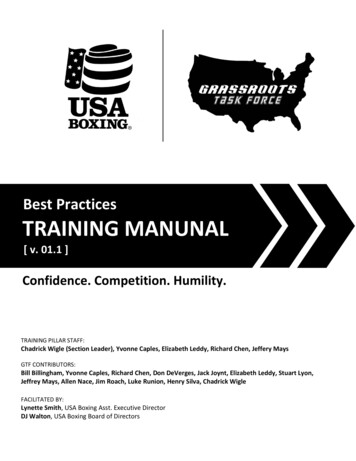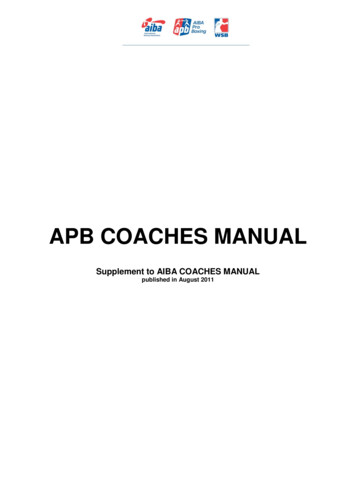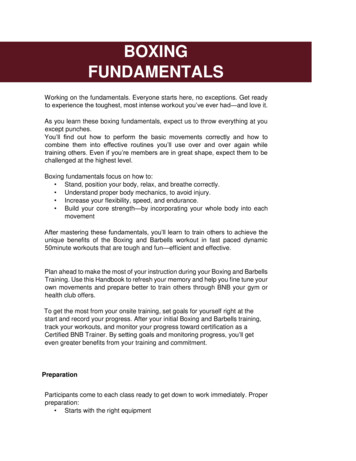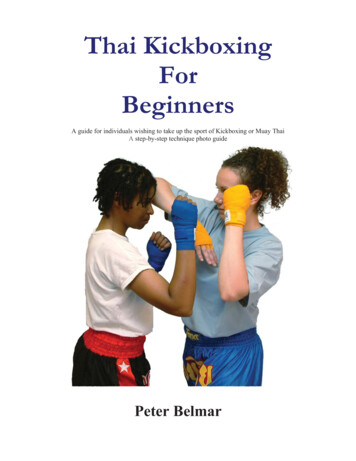
Transcription
au t h o r n a m eBook templateAn InDesign template for books, eBooks, papers and reportsThis template is designed by Otto Coster and provided to you by Smashing Magazine
DAY 1 - Stance & FootworkTip #1 - How to Tell If Your Stance is BalancedHere is a little trick you can use to see if your weight is evenly distributed across both feet:try lifting one foot off the ground without shifting your body weight. Then try the otherfoot. If you feel one foot is much harder to lift, there is probably more weight on that leg.Now see if you can tell when your opponent has too much weight on one leg. If so, he willsuffer have mobility and also telegraph which side he likes to punch from.Tip #2 - Avoid the Wide StanceA wide boxing stance is not typically recommended for beginners because of manydrawbacks. It uses a lot of leg energy because of poor balance and mobility. Your backhand is also further away from your opponent making it hard to reach with your crossunless you lean your head in (dangerously towards your opponent).Tip #3 - Point Your Front Foot Towards OpponentMake sure your front foot is always pointing towards your opponent. This keeps youropponent “inside your shoulder” allowing you good power and reach with both hands. Ifyour opponent is positioned outside your front foot, he is also likely to be “outside yourshoulder” making it harder for you to reach him with punches.Read more articles on boxing stance: The Perfect Boxing Stance Perfect Boxing Stance Width Boxing Stance 101 Why the Strong Arm Belongs in the BackFREE Boxing Course ExpertBoxing 2
DAY 2 - Straight PunchesTip #1 - Increase Jab Power by Dropping Your HipsWhen you jab, step forward an inch with your front foot and relax your hips to drop yourbody weight into the jab. Time your jab so that your fist impacts right when your weightdrops into the ground. This is also known as Jack Dempsey’s “Falling Step” principle.Tip #2 - Don’t Look Down When Attacking the BodyKeep your eyes look at your opponent’s head and shoulder area when you attack his body.Looking at his body telegraphs your attack and makes it harder for you to see his counterpunches.Tip #3 - Relax the Chest to Load the Right CrossThere’s a trick to load extra power in your right cross without pulling the fist back (and risktelegraphing it). Relax your right chest allowing your right shoulder to stretchfurther backand then pop your right fist forward as you rotate your body for the punch. This allows youto load your punch without leaving yourself wide open.Read more articles on straight punches: 5 Types of Jabs The Ultimate Boxing Jab GuideFREE Boxing Course ExpertBoxing 3
DAY 3 - Curved PunchesTip #1 - Horizontal vs Vertical fisted hooksA horizontal fist is for shorter hooks or on the inside. A vertical fist is for longer hooks orwhen you want to punch AROUND an opponent’s guard. Some boxers aren’t comfortablethrowing a vertical-fisted hook, so they throw with a horizontal fist. Use what feelscomfortable for you.NOTE: All hooks to the body are thrown with a vertical fist or even with an upside down fistlike an uppercut.Tip #2 - Contract the Chest & Shoulder Muscles TogetherWhen you throw the hook, tighten the chest and shoulder together. The hook becomesjust an arm punch if you leave the chest or shoulder relaxed. The key is contracting thechest and shoulder together so that your arm becomes an extension of your body and notjust a free weight being swung around. It also helps to tighten your bicep when you throwhooks.Tip #3 - Throw Uppercuts Without Shifting WeightIt’s sometimes more practical to throw uppercuts without shifting your weight. If you’rein close range, it will be faster and more powerful to leave your weight over one leg andthrow from that side. Or maybe you’re looking to throw 2 uppercuts or 2 hard punchesfrom one side then again, leave your weight on that side. If you’re throwing a rightuppercut, leave your weight on the right leg. If you’re throwing a left uppercut, leave yourweight on the left leg. Remember to pivot that foot hard!Read more articles on curved punches: How to Setup Hooks to the Body How to Throw an Uppercut Mastering the Left HookFREE Boxing Course ExpertBoxing 4
DAY 4 - Basic DefenseTip #1 - Touch Your Head or Pull Your ElbowsBlocking is the easiest defense to master. To cover yourself, you simply have to recover yourgloves. Touch your head to block head shots, and pull your elbows in to block body shots.Focus on recovering your arms instead of trying to chase the punch.Tip #2 - Use Parries Against Long PunchesParries are most effective against long and straight punches. Block like you normally wouldbut shift your guard at the moment of impact to deflect your opponent’s punch awayfrom you. This motion can tire out your opponent’s arms and make him vulnerable to yourcounter. Parries are especially useful against taller punchers that commit more shouldermuscle to pull their arms back.Tip #3 - Use Footwork as DefenseThere’s no rule saying you have to stand there and take punches. If you don’t plan on firingback, it’s much easier to take a step out of harm’s way. You don’t need any fancy footwork,walk out of range. As long as you keep your feet moving, it will be hard for your opponentto ground his feet for a hard punch. Footwork makes a great defense because it breaksyour opponent’s rhythm instantaneously. Anytime you get overwhelmed by punches, takea back step and watch him miss.Read more articles on boxing defense: How to Parry Punches 3 Levels of Defense The Meaning of DefenseFREE Boxing Course ExpertBoxing 5
DAY 5 - Advanced DefenseTip #1 - Roll Punches by Turning AWAY From ThemTo roll off a punch, simply rotate your body right at the moment of impact to deflect thepunch off your shoulder. DEFEND with the timing of the roll and rely on the deflectionrather than the covering with your shoulders.Tip #2 - Roll UNDER Punches by Turning INTO ThemTo roll under punches, make sure you turn away from them first so that their impact isminimized if they land. Bend your knees as you turn away first and then turn back into thepunch as you roll under them. When rolling quickly under punches, focus on turning yourshoulders instead of jerking your head around in a loop.Tip #3 - Slip By Moving Your Head Past the CenterSlip punches by trying to cut your head past the middle. Focus on cutting across the centerinstead of trying to pull your head to one side. It helps to place your head to one sidebeforehand and then bring it to the other, this way your opponent punches to one side asyou move to the other side.Read more advanced boxing defense guides: How to Shoulder Roll How to Slip Punches Boxing Defense TechniquesFREE Boxing Course ExpertBoxing 6
DAY 6 - Punch CombinationsPunch Numbering System1 jab2 right cross3 left hook4 overhand right (or wide right)5 left uppercut6 right uppercutb body// slipExamples of Common Punch Combinations: full combo 1-2-3b-2 inside combo - 3-6-3 along the ropes tricky combo - 1-3-2 advanced combo 1-2-3-/2/-3-2-/1/-2-3-2 counter combos /1/-/2/-3-2 southpaw combo 1-2-/2/-2-3-2-1Want to try more punching combinations? Johnny’s Punching Combination List 7 Basic Boxing Combinations 7 Attack Rhythms for FightingFREE Boxing Course ExpertBoxing 7
DAY 7 - Counter PunchingExamples of Classic Counter PunchesTo counter the , use JAB - parry & counter right RIGHT - pivot left hook (overhand) WIDE RIGHT - lean back and counter LEFT HOOK - roll under & counter right LEFT HOOK to the body - elbow block & counter right SOUTHPAW JAB - slip & counter right to the bodyRead more counter-punching guides: 7 Easy Boxing Counter Punches Baiting and Forcing Counters 3 Basic Counters for Southpaws Against Orthodox BoxersFREE Boxing Course ExpertBoxing 8
DAY 8 - Advanced SkillsTip #1 - Focus on the Exhale (BREATHING)The trick to boxing breathing is controlling the exhale. Exhale when you make a sharpmovement whether it be a punch, slip, or quick step. A sharp exhale creates a sharpmovement. By not exhaling all of the air in your lungs, you have more air to throw morepunches and make more explosive movements. Work on controlling your exhalations andyour inhalations will happen naturally.Tip #2 - Counter Explode When You BlockBreathe out when you block as though you are punching back at your opponent using hisarm. At the same time you contract your core for a split second to repel the shot. Counterexplode by activating your lats and leg muscles, then dropping your weight to transferenergy to the ground. A perfectly timed counter-explosion off a block can push youropponent off balance simply by blocking.Tip #3 - Punch Harder and Faster By Releasing the PunchThe trick to power punching is contracting and releasing your muscles at the right moment.Your body should start out relaxed and then contract explosively to fire the punch but thenrelease right at the moment of impact allowing the energy to transfer to the opponent. Ifyou relax too early, the punch will weaken. If you relax too late, you waste precious energythat only pushes your opponent. Relax at the right time and your punch will explode onyour opponent. This is also known as the snapping punch.Read more advanced boxing guides: How to Throw a Snapping Punch How to Punch HarderFREE Boxing Course ExpertBoxing 9
DAY 9 - Boxing TrainingTip #1 - Don’t Rest on the Heavy BagA horizontal fist is for shorter hooks or on the inside. A vertical fist is for longer hooks orwhen you want to punch AROUND an opponent’s guard. Some boxers aren’t comfortablethrowing a vertical-fisted hook, so they throw with a horizontal fist. Use what feelscomfortable for you.NOTE: All hooks to the body are thrown with a vertical fist or even with an upside down fistlike an uppercut.Tip #2 - Shadowbox SparringWhen you throw the hook, tighten the chest and shoulder together. The hook becomesjust an arm punch if you leave the chest or shoulder relaxed. The key is contracting thechest and shoulder together so that your arm becomes an extension of your body and notjust a free weight being swung around. It also helps to tighten your bicep when you throwhooks.Tip #3 - Daily Amateur WorkoutMost amateur boxers workout 5 days a week (rest on weekend). Every day has 2-3 miles ofrunning, Warm-up 3 rounds on the jump rope, 3 rounds shadowbox, then technique drillsand exercises. After sparring or more intense conditioning workouts, they warm down with3 rounds each on heavy bag, speed bag, double-end bag, and mitts. Then comes the dailycore workout of push-ups, sit-ups, and crunches.See more training guides: ExpertBoxing EASY Boxing Workout Top 5 Boxing Exercises The Perfect Training PaceFREE Boxing Course ExpertBoxing 10
DAY 10 - Boxing SparringTip #1 - Great Sparring DrillsJab Sparring - It’s a great way to warm up before sparring. Do one round of sparring usingonly the jab.“Center Ring” Sparring - Spar with both fighters only punching at center ring. Themoment one fighter retreats to the ropes, the other one backs off. It’s a great way forbeginners to get accustomed to sparring by giving them a “safety zone” to retreat to.“Forwards & Sideways” Sparring - have fighters work on their defense and lateralmovement by not allowing them to move backwards. They are only allowed to go forwardsor circle around their opponent. This teaches good movement habits that allow them tomaneuver around opponents without backing into the ropes.Tip #2 - Aggressive DefenseWork on trying to be more offensive. Be offensive even when you’re defending. So basicallyyou’re always using offense and counter-offense. Never go into a passive defense modeand make yourself a sitting duck for punches. Always look for offensive opportunities whenyou defend. Try to get closer or get into punching range when you evade.Tip #3 - Aim for the ChestIf you can’t hit the head, go for the chest. It’s hard for opponents to slip or roll under chestpunches so they will be forced to block. Even if you do no damage, at least you’re able totouch your opponent on a consistent basis. Then slowly start aiming your way up towardsthe head. This tip is important for beginners that feel they can’t hit their opponents’ heads(because they’re slipping too fast).FREE Boxing Course ExpertBoxing 11
More guides on sparring: Boxing Sparring for Beginners Boxer’s First Spar Checklist Why Beginners Shouldn’t Spar With Bigger Opponents How to Fight Tired How to Lose a Fight Skillfully How to Beat a Better Fighter How to Fight a SouthpawFREE Boxing Course ExpertBoxing 12
Learn How to Box in 10 Days!Did you enjoy the free tips?These free tips were taken directly from my boxing instructional ebook and video. If youenjoyed these tips, you should check out my acceleraterated boxing course, “How to Boxin 10 Days”. It’s specifically to help beginners learn the basics and improve their fightingability as fast as possible.“How to Box in 10 Days” consists of a 300-page instructional ebook, 32-pageworkbook, and 1hr 45mins of video instruction. Check out “How to Box in 10 Days”Share These Tips With Your Friends!Feel free to share these tips with other fighters and fitness enthusiasts. Thanks for being apart of our great sport. Keep training hard and I hope to see you on TV one day.Johnny Nguyen,Founder of ExpertBoxing.comFREE Boxing Course ExpertBoxing 13
FREE Boxing Course ExpertBoxing 10 DAY 9 - Boxing Training Tip #1 - Don’t Rest on the Heavy Bag A horizontal fist is for shorter hooks or on the inside. A vertical fist is for longer hooks or when you want to punch AROUND an opponent’s guard. Some boxers aren’t comfortable throwing a vertical-fisted hook, so they throw with a horizontal .File Size: 2MB










